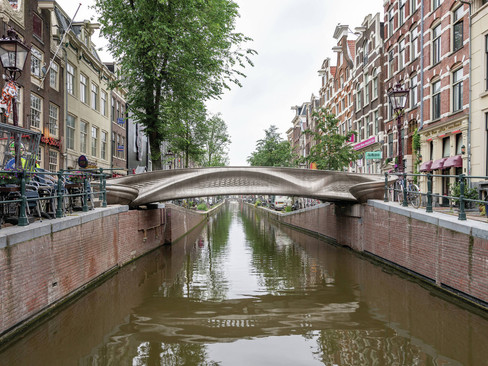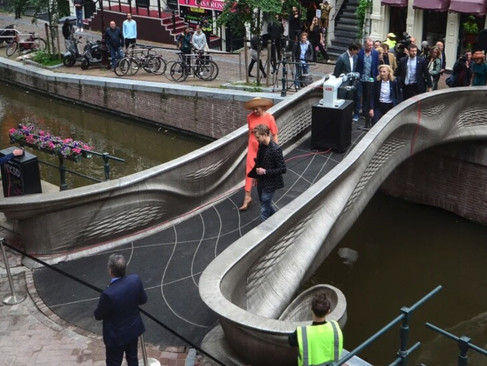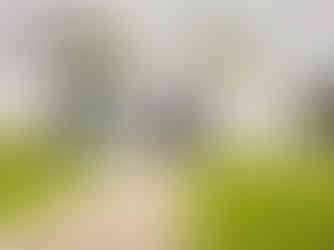Can 3D printing be used for manufacturing?
- Trem-din

- Mar 10, 2023
- 6 min read
It is likely that by now, you are already somewhat familiar with 3D printing. However, one of the most frequently asked questions in this area is: how and to what extent is it possible to get the most out of this type of manufacturing in your company?
To answer this and other questions of a similar nature, this blog is of interest to you. We will start with a brief introduction about what it is and how it works, you will learn about its advantages and disadvantages, and you will understand which type of material and process is the most suitable depending on the part to be produced and the various applications that are currently the most successful.

Three-dimensional printing is a term that has been on the lips of many industries in different sectors (design, architecture, dentistry, etc.) for years. It started as an innovative idea but with many aspects to develop and improve. Therefore, in the last decades, this technology has become popular and greatly impacted the manufacturing industry.
What is 3D Printing and how does it work?
3D printing is a manufacturing process that, through a digital 3D model and its technology, allows the creation of three-dimensional objects by superimposing constant layers of a given material. Therefore, it is necessary to understand how this technology works in order to achieve optimal printing.

Advantages and disadvantages of 3D printing
Like any process, it has its advantages and disadvantages. It is essential to understand the different particularities of this technology in order to know how to implement it in your company. Using it properly is a way to optimize the desired results in the long term.
Additive manufacturing is efficient, speeds up and simplifies processes, is easy to repair in case of production failures, lowers prices in the prototyping phase, reduces logistics costs, allows the generation of complex shapes and offers freedom of design, little material waste and is an accessible manufacturing process. It is also considered a sustainable alternative since the remaining material can be recycled, reduces programmed obsolescence (construction of parts for machines that are difficult to repair) and reduces energy consumption and emissions. However, despite its many benefits, there are some drawbacks. Mainly, the finishes are inferior compared to other types of technologies, more focused on mass production, such as those mentioned in our blog on "plastic production". In addition, in sectors such as food and health, the type of material used and its compatibility with the technology to be used must be taken into account.
Materials and types of 3D printing processes
Since the beginning of additive manufacturing, the supply of materials has been growing and being driven toward change due to sustainability. Depending on the properties and finishes that are intended to be attributed to the part we can highlight the following groups:
Polymers in 3D printing manufacturing
It is the most widely used group in this manufacturing technique. Two types can be distinguished: thermoplastics and thermosetting. The latter, waste materials cannot be reused because they decompose instead of melting and do not re-form when cooled. In conclusion, they remain in a permanent solid state after curing.
The most common technologies applied to this material are:
Fused deposition (FDM): melts the filament material and extrudes the filament by depositing it layer by layer on the print bed. The most popular materials are ABS, PLA, Nylon, TPU (flexible prototypes, PVA (dissolution of supports in water), and composites (carbon fiber, glass fiber, and kevlar).
Stereolithography (SLA): a photopolymerization process that cures thermosetting liquid resins with a laser and transforms them into hardened plastic. It is very versatile and offers a variety of resin formulas according to properties. These include standard, flexible, and elastic resins, medical and dental resins (medical and dental devices, prostheses, etc.), and resins for jewelry and ceramics (works of art, design, etc.).
Selective laser sintering (SLS): uses a high-power laser to melt small particles of thermoplastic powder. Suitable for complex geometries despite its slightly rough finish.

Metals in manufacturing with 3D printing

(Titanium, stainless steel, aluminum, nickel alloys) is a considerably more expensive technology and requires high investments and the training of much more specialized technical personnel. This makes access to this machinery difficult for small companies, although there is always the possibility of contracting external manufacturing services. The most common technologies applied to this material are: FDM (binder removal by the furnace), SLM and DMLS (melt metal powder particles).
Ceramics in manufacturing with 3D printing
They use as raw material a mineral substance, such as sand or clay, which depending on its composition and additives can be of structural, technical, refractory, etc. type. The selection of the same will depend on the intended use. At the same time, regardless of the choice of material, they all have the possibility of providing the piece with great mechanical properties and high-resolution geometries. However, it is not a technique as well established as those explained above.
Similarly, there are different methods known as:
SLA: process similar to the one applied for polymers. It requires post-processing.
DLP: a method that, instead of using laser, employs a video projector. It manages to cover more of the area at a higher speed.
Binder Jetting: manufacturing method using ceramic powders bound by a binder, which solidify on a bed of powder.

Liquid Deposition Modeling (LDM): technique similar to FDM. It differs because the material changes and, in addition, the extruders are adapted to it.

Therefore, the variety of materials and adaptations of the technology in this field has been growing exponentially, giving rise to experimentation with others that are not as common as the aforementioned. For this reason, we would like to refer to innovative companies to show you how production is possible and to provide you with a more global vision of how you can implement this methodology in the development of products for your projects.
Production with 3D printers
Emerging Objects is an American company that, through the implementation of creativity in additive manufacturing, has managed to stand out in the world of architecture and construction, generating environments for the 21st century.
Saltygloo: At the end of 2013, the American corporation exhibited at the Museum of Craft and Design this experiment. It consists of a 5-year process using salt harvested from crystallization ponds in the San Francisco Bay. The resulting material for 3D printing is a composition of the "salt casting" together with a glue.

Utah tea sets: innovative set printed three-dimensionally with tea.

ColorFabb is a Dutch company that developed wood fiber filaments mixed with PLA/PHA to achieve quality and "natural" finishes. They are known as BambooFill, CorkFill and WoodFill and can be used to make figures, furniture or decorative products.

The Dutch company MX3D was in charge of the design and construction of the 3D printed steel bridge (6,000 kg) located in Amsterdam's Red Light District. It was built with the aim of solving the permanent pedestrian and cyclist traffic for two years while the old footbridge is being renovated. The structure took half a year to build thanks to 4 industrial robots.
The "Milestone" project was made possible through a joint collaboration between the city of Eindhoven, Eindhoven University of Technology, Van Wijnen, Vesteda, Weber Beamix and Witteveen + Bos. Its aim is to build five concrete houses in an ergonomic, sustainable, lightweight and silent way using 3D printing. In doing so, it becomes the first commercial housing scheme applying this technology. It allows them to obtain a timeless design with freedom of form by merging 2 concepts: nature and construction.
The designs of the young Dutchman, Olivier van Herpt, attempt to amalgamate the digital and analog worlds to build new methods and means of production. Among the highlights, we note his project titled 3D Dripping inspired by how stalagmites and stalactites are created through computer-monitored heating and randomly tearing kerosene. The piece rotates under the extruder while a fan cools the material.

The Adidas 4DFWD (2022) is another of the great achievements of the well-known sports brand Adidas in collaboration with Carbon's Digital Light Synthesis. In this case, we are talking about the most futuristic and advanced sneakers on the market.

They have a 3D printed midsole and, thanks to this reticular structure design, it offers the runner comfort and efficiency in the race as it provides greater cushioning compared to other models on the market. In addition, the innovative midsole perfects the user's jogging by harnessing vertical energy and transforming it into horizontal force.

Finally, the U.S. company Align Technology, which specializes in orthodontics through additive manufacturing, has achieved mass production of Invisalign aligners. Obviously, each splint and mold is customized according to the user's oral anatomy. This revolution has made them leaders in the dental sector.
The implementation of 3D printing in the design and development of your company's products is a process that will allow you to save time in the development phase. However, it requires knowledge to maximize and take full advantage of the benefits provided by this technology.
If you have any questions, do not hesitate to contact us. From Trem we are looking forward to hearing about your idea listening to you, guiding you and helping you in the development of your project and achieving a successful result.












Comments